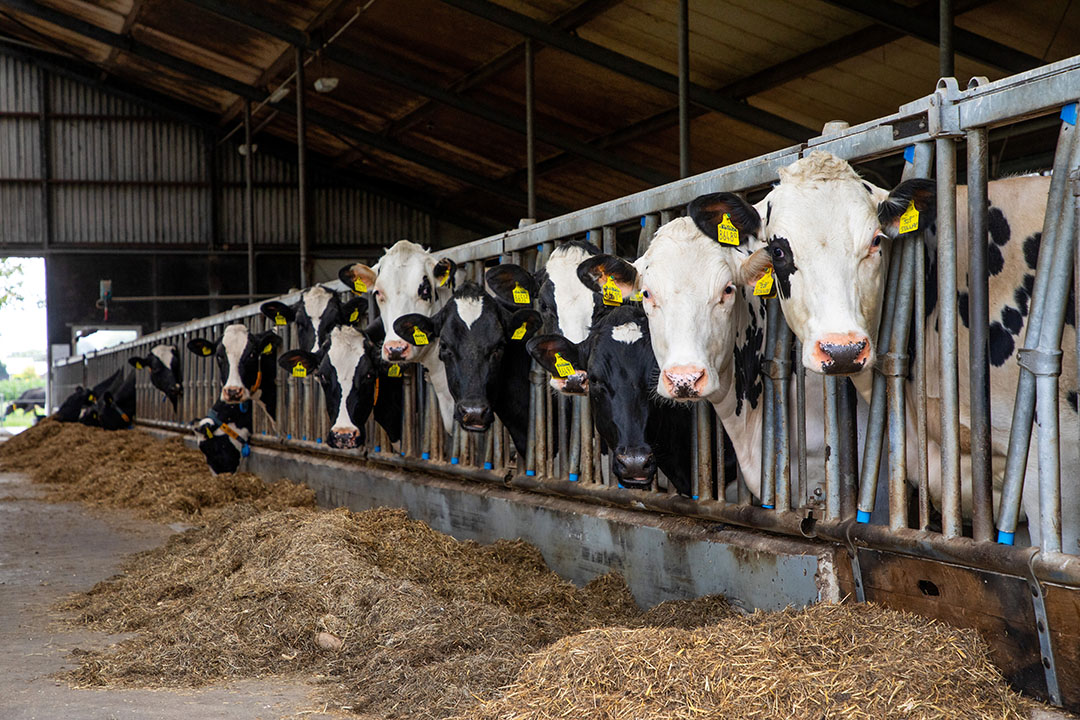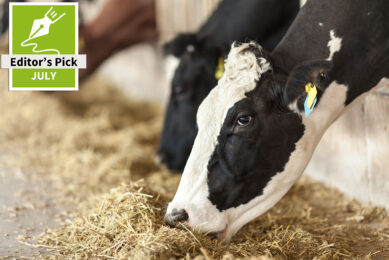Microbial diversity for ruminants

The gut plays a critical role in health and wellbeing and accommodates a vastly complex community of micro-organisms.
Inoculation occurs immediately after birth, with diversity and complexity increasing until it has reached a relatively steady state. This diversity is crucial to the gut’s function as a protective barrier and provides resistance to colonisation of pathogenic organisms while having beneficial effects on the immune function.
The ruminant has a digestive strategy that relies on an intimate relationship with various micro-organisms and, as such, can utilise feedstuffs that other animals cannot. Mammals have little-to-no ability to degrade fibrous plant material. But, bacteria, protozoa and fungi produce cellulases, a group of enzymes that can breakdown cellulose and other related polysaccharides found in plant cell wall material. The ruminant foregut houses an ecosystem of these anaerobic microbes that allows ruminants to obtain nutrients from not only fibrous plant-based material but also the microbes themselves. This strategy allows ruminant agriculture to produce human-edible product from human-inedible feed (i.e., forage).
General gut physiology
The gastrointestinal (GI) tract is the primary site of nutrient absorption and digestion. It is also the largest endocrine organ of the body. However, the epithelial lining is only a single layer of cells that, together, absorb nutrients, provide a barrier protecting internal tissues and produce protective mucin and antimicrobial compounds. The intestinal epithelium consists of villi (Figure 1), finger-like projections into the gut lumen, that greatly increase the surface area available for absorption. The epithelial layer consists of several different types of cells, which, together, influence gut integrity and defence against pathogens. The primary absorptive cells, enterocytes, are the most abundant and these are covered in microvilli. They secrete antimicrobial proteins with activity against bacteria, fungi and protozoa.
Enterocytes are tightly packed together via ‘tight junctions’ to form a physical barrier which prevents unfettered access of fluid, bacteria and other substances into the body system. If the tight junctions are defective, the gut becomes more permeable, and the term ‘leaky gut’ is used to describe a condition associated with diarrhoea and poor growth. Goblet cells are also present in the epithelium and these produce mucins, proteins that form the protective mucus barrier over the gut surface. At the bottom of the villi crypts are Paneth cells that generate antimicrobial materials and these play an important role in immune defence. In addition to the distinct cell types comprising the epithelium, an entire ecosystem of microbes − termed the gut microbiota − resides within the GI tract. This microbial community within the gut is involved in pathogen control, immune function, nutrient provision and intestinal morphology.

Click here to enlarge this figure
The rumen ecosystem
The rumen essentially acts as a large fermentation vessel where bacteria, protozoa and fungi digest and degrade fibrous and non-fibrous plant material, as well as protein and non-protein nitrogen sources. There is also digestion and modification of lipids by bacterial lipases and biohydrogenation. End-products of rumen fermentation are either absorbed directly through the rumen wall − for example, volatile fatty acids (VFA) − or in the small intestine (SI) − for example, small peptides/amino acids and lipids. Dead microbes are also washed through the forestomach and can be digested and absorbed in the SI, thus making a significant contribution to the host’s nitrogen requirement.
The rumen ecosystem consists of 4 groups of microbes: bacteria, protozoa, fungi and archaea. There are also bacteriophages, mycoplasmas and archaeophages. In terms of numbers, bacteria are by far the most abundant at 1010 -1011 cells/ml, followed by archaea (106 -108 cells/ml), protozoa (105 cells/ml) and fungi (103 -105 cells/ml). Bacteria make up around 2/3 of the rumen microbial biomass, with protozoa making up to 50%, due mainly to their size.
Rumen bacteria
Bacteria are a diverse, plastic group with a core community that appears relatively consistent across diets. While much research has historically focused on individual strains, recent research has started to look at the whole bacterial community in response to changes in the rumen environment, namely dietary changes. Studies of rumen bacteria have shown 3 major phyla that comprise the core community, irrespective of diet: Bacteriodetes, Firmicutes and Proteobacteria.
 Mitigating methane production in the rumen
Mitigating methane production in the rumen
Several feeding strategies can be adopted to reduce methane production in the rumen. In this article, however, the focus is on the use of fat supplements in the animal’s diet.
A large-scale study examining microbial communities across a range of ruminant and camelid species, diets and geographical regions found that 7 bacterial groups accounted for over 60% of the bacterial samples they sequenced. The authors hypothesised that, even though we can identify the ‘core’ species, more research is required in order to understand them and their role in the microbial community. Similarly, an earlier meta-analysis revealed that 19 bacterial phyla were present in the rumen microbiome. According to this meta-analysis (the Ribosomal Database Project), 71% of the bacterial species have been covered, meaning that around 30% remain unknown. A core microbiome notwithstanding, diet appears to have a major effect on bacterial diversity.
Rumen protozoa
Protozoa are comparatively large microbes that are present in the rumen at a concentration of ~105 cells/ml. They play a crucial role in providing nutrients for hosts, as well as the generation of methane. Protozoa produce a great deal of butyrate and acetate, which yields hydrogen molecules that are subsequently taken up and converted into methane by methanogenic archaea. It is well-established that defaunation results in a reduction in methane output and this has also been shown to improve the efficiency of nutrient use. It is also known that protozoa predate bacteria within the rumen microbial community. This negatively impacts microbial protein synthesis and, subsequently, nitrogen use efficiency in the cow. Protozoa have also been implicated in the generation of conjugated linoleic acid (CLA) isomers. Although many studies have examined protozoal effects, far less is known about rumen protozoal communities and diversity compared with bacteria.
 The rumen microbiome’s role in increasing animal efficiency
The rumen microbiome’s role in increasing animal efficiency
The demand for more animal protein, especially from ruminants, must be met using less land, water and with a significant reduction in the environmental footprint of livestock production systems.
Rumen fungi
Fungi are the largest of the rumen microbes, with the longest generation time. There are 6 genera: the monocentric Neocallimastix, Piromyces, and Caecomyceas and the polycentric Oprinomyces, Anaeromyces, and Cyllamyces. They are perhaps best known for their ability to degrade fibre by burrowing into cell-wall material, rendering it more accessible to bacterial enzymes and, ultimately, increasing ruminal fibre degradation. Fungi have also been shown to partially biohydrogenate linoleic acid to t11 C18:1. Like rumen bacteria, fungal diversity is affected by diet.
Archaea
Many archaea are methanogens, and these are responsible for generating methane from substrates such as hydrogen and carbon dioxide. Compared with bacteria, rumen archaea appear to be much less diverse. However, an increase in methanogen numbers does not necessarily translate into greater methane production, as rumen conditions may affect the expression of genes in methane production. There are known associations between both rumen cellulolytic bacteria and archaea, as well as protozoa and archaea. The link is hydrogen, which archaea use to reduce CO2 to methane. Protozoa are known hydrogen producers and archaea associate with protozoa to make use of the available hydrogen. Methane production is thus used as a hydrogen sink to try to avoid significant drops in rumen pH.
 Eucalyptus reduces methane in dairy calves
Eucalyptus reduces methane in dairy calves
Mitigating methane production is still a major concern in dairy production. Researchers are turning to sustainable and environmentally friendly strategies.
The role of the gut microbiota
The gut microbiota can vary greatly between individuals, depending on genotype, age, environmental factors, diet and the use of antimicrobials. However, despite this variation, ~90% of the contributing organisms are of the phyla Bacteriodetes and Firmicutes. The gut microbiota can profoundly influence the health of the host and it has been implicated in many disease states, including insulin resistance, pancreatic disease and cardiovascular disease, to name but a few conditions. Animals are born with no effective gut microbiota and inoculation and colonisation begins to occur immediately after birth. Colonisation both educates the immune system and moderates its reaction to antigens, while providing nutrients, such as some vitamins and amino acids, as well as short-chain fatty acids. It is well established that the gut microbiota can have a significant role in food-component digestion and absorption and can have a positive effect on energy release from the diet.
A diverse population of commensal bacteria can inhibit enteropathogens colonising and infecting the gut; this is called ‘colonisation resistance’. Effective colonisation resistance requires a highly diverse and complex microbiota, and animals with low diversity are likely to be more susceptible to enteric pathologies. Reduced gut microbial diversity increases the risk of colonisation of pathogenic bacteria, resulting in gut inflammation and a potential systemic response. There is evidence to suggest modulation of the immune function by the gut microbiota. Gut microbes modulate the expression of certain receptors in the gut that affect gut permeability. Imbalances in gut microbiota can lead to increased gut permeability and unregulated proinflammatory cytokines, as well as metabolic endotoxemia and insulin resistance.
 Converting organic residues into fatty acids for animal feed
Converting organic residues into fatty acids for animal feed
Amsterdam-based company ChainCraft has developed a fermentation technology to produce fatty acids from fruit and vegetables residues.
Factors affecting the gut microbiota
These can be broadly categorised into 3 classes: host-associated, biotic and abiotic. Host-associated factors include the host’s own genetic make-up, and heritable taxa have also been identified. The host’s immune system also plays a role. By far, the most influential factors are environmental and the food source. Host lifestyle and diet play a key role in the development and maintenance of the gut microbiota, with environmental sources of microbes contributing to colonisation immediately after birth. Diet and medication have a significant impact on the microbial community within the gut, with medications accounting for the most significant variation between individuals. For example, diet is the major determinant of rumen bacterial community structure.
Medication − including, but not limited to, antibiotics − has a significant impact on gut microbiota and, subsequently, host health. Antibiotic use results in changes in the intestinal microbiota (Figure 2) and a reduction in diversity and complexity due to their non-specific action. Subsequently, colonisation resistance decreases, and animals are rendered more susceptible to enteric pathogens. This reduction in colonisation resistance has been implicated in one of the greatest threats of this and subsequent generations: antimicrobial resistance (AMR). Worryingly, even with a decline in the use of antimicrobials, there is still antibiotic resistance in animals that have not received antibiotic growth promoters (AGP), and thus simple restrictions are not enough to promote microbial diversity and combat resistance (Figure 2).

The rumen microbiota is a diverse and complex ecosystem that dictates rumen health and function. Rumen bacteria are probably the microbial group that has been studied most. However, it is only in the last few years that we are starting to get a picture of the extent of the diversity and nature of rumen bacterial strains. The gut microbiota has a significant influence on host health, immunity and physiology and can play a role in helping to reduce reliance on antimicrobials. However, a diverse and complex microbiota is required in order to maximise resistance to colonisation by pathogenic species and reduce the susceptibility to disease.











